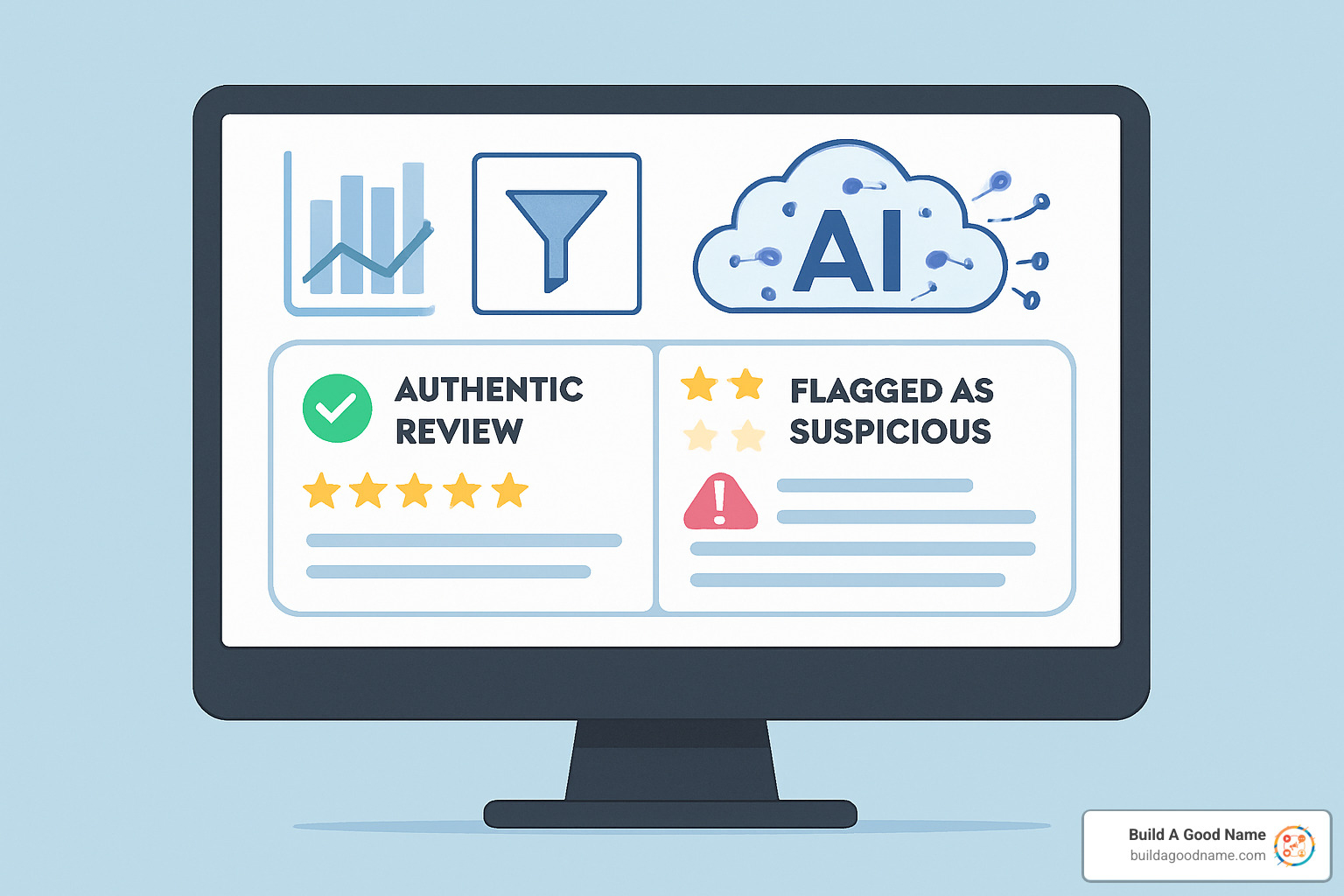The Challenge of Trust in a Sea of Feedback
A review filtering tool is software that automatically identifies and removes fake, biased, or unnatural reviews from your business’s online presence. These tools use AI and machine learning to detect suspicious patterns, helping businesses maintain authentic customer feedback while protecting their reputation from fraudulent reviews.
Key capabilities of review filtering tools:
- Detect fake reviews using pattern recognition and sentiment analysis
- Monitor multiple platforms (Google, Facebook, Amazon, etc.) from one dashboard
- Automate response management with AI-powered replies
- Generate analytics to track review authenticity and customer sentiment
- Alert businesses to suspicious review activity in real-time
The stakes couldn’t be higher. Online reviews now influence a staggering $791 billion of eCommerce spending annually in the U.S. alone. Yet the system is broken – 62% of consumers believe they’ve seen a fake review in the past year, but 84% don’t always know how to spot one.
This creates a perfect storm for businesses. 56% of customers won’t buy a product if they suspect fake reviews, and 81% of consumers will avoid using a brand again if they lose trust due to fraudulent feedback.
For busy business owners, this means every fake review is a potential customer walking away. Every suspicious pattern damages the trust you’ve worked years to build. The noise is drowning out authentic customer voices – the ones that actually matter for improving your business.
The good news? Modern review filtering technology can cut through this chaos, helping you focus on real feedback while protecting your reputation from manipulation.
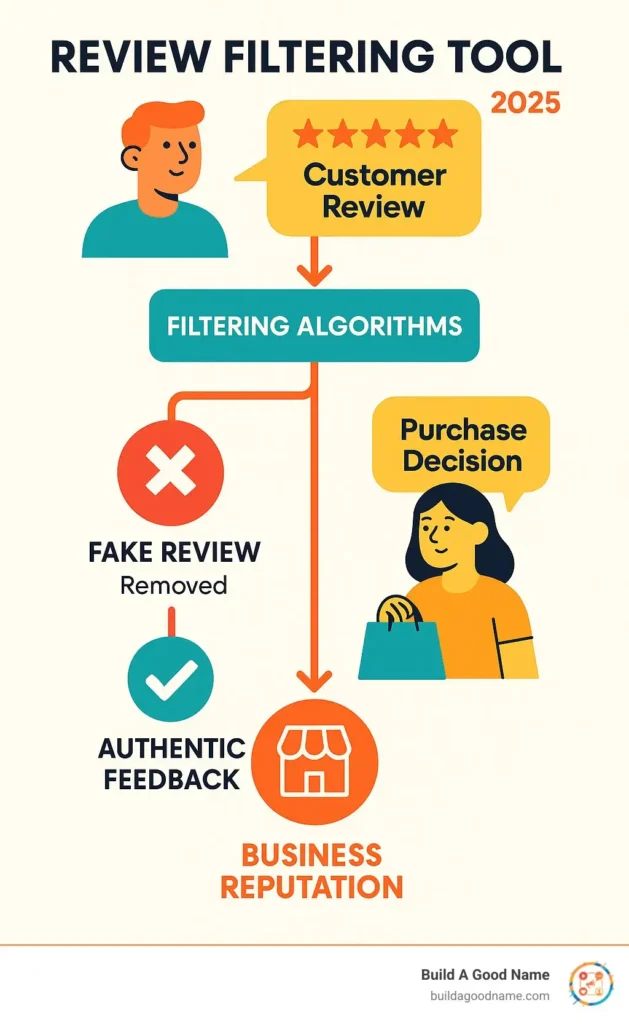
Why Review Filtering is Crucial for Modern Businesses
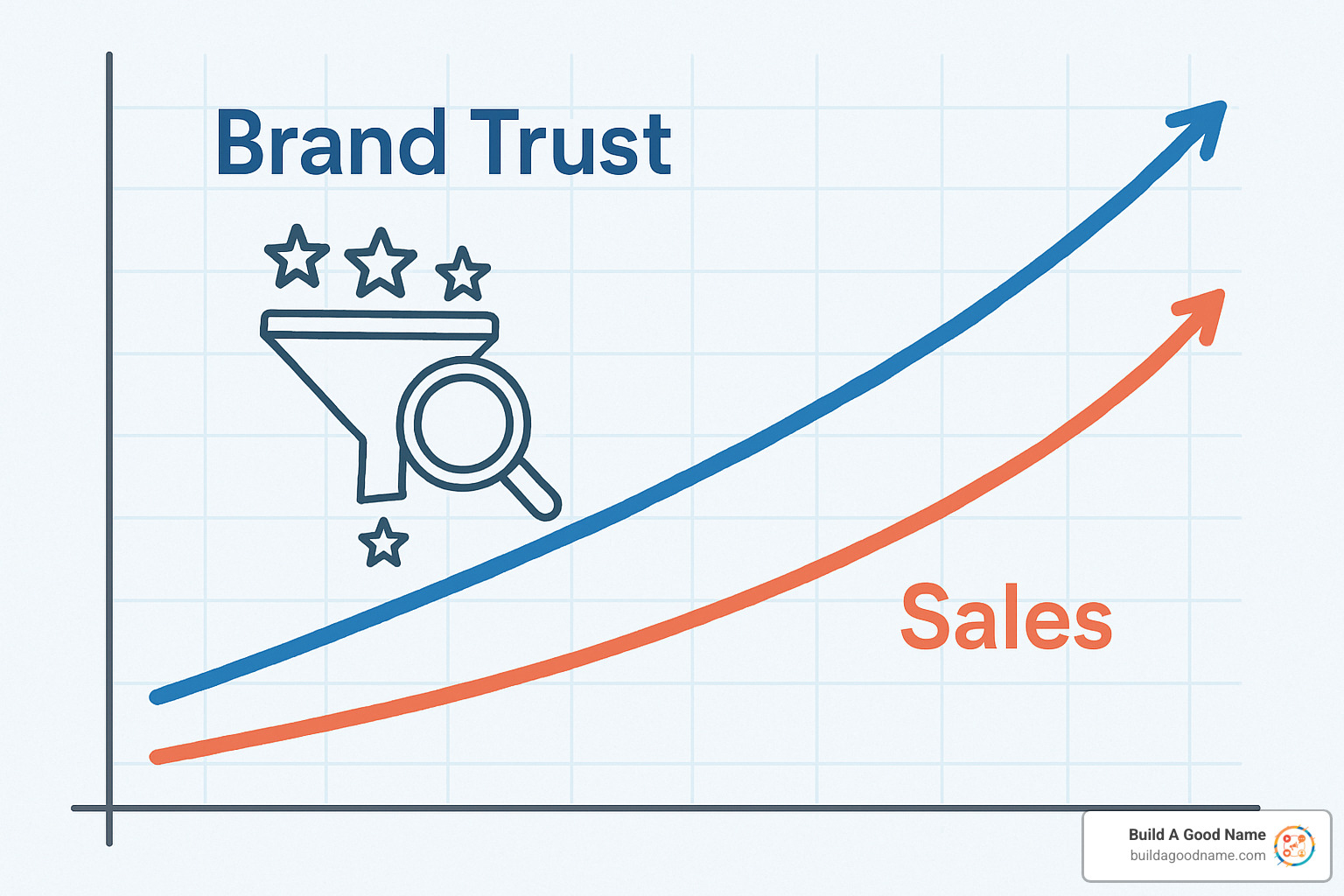
Online reviews influence nearly $791 billion of U.S. e-commerce spending every year, yet more than half of consumers say they have spotted fakes. The result is simple: when buyers don’t trust what they read, they don’t buy. A review filtering tool restores confidence by keeping only genuine voices in front of would-be customers.
- 56 % of shoppers abandon a purchase if they suspect fake reviews.
- 81 % won’t return to a brand they feel manipulated them.
- Clean review profiles lift local SEO, driving organic traffic and phone calls—vital in competitive markets like Online Reviews and Reputation Management Lake Elsinore.
Filtering is therefore not a “nice-to-have.” It is risk mitigation, trust insurance, and a sales accelerator rolled into one. Modern Reputation Management Tools combine filtering, monitoring, and automated replies so you deal with insights, not noise.
The High Cost of Inaction
Ignoring fake reviews is expensive:
- Lost sales: Just a 10 % drop in conversions at $100 AOV and 1,000 monthly visitors costs $120,000 a year.
- Brand erosion: Rebuilding broken trust can take years.
- SEO drag: Search algorithms downgrade profiles with suspicious activity.
- Legal exposure: The FTC’s Section 5(a) treats deceptive reviews as unlawful advertising.
The Consumer Perspective
Customers face information overload and often lack the skill—or time—to sift fact from fiction. A transparent, well-filtered review feed stands out immediately. When shoppers sense authenticity, hesitation disappears and conversion climbs. In short, filtering turns chaotic feedback into a competitive advantage.
How Review Filtering Technology Works
Think of a review filtering tool as a digital detective that never sleeps. These sophisticated systems work behind the scenes, analyzing thousands of data points to separate genuine customer feedback from fake reviews. But they’re not just looking at what reviews say – they’re examining how they’re written, when they appear, and who’s posting them.
The magic starts with AI and Machine Learning algorithms that have been trained on millions of reviews. These systems learn to recognize patterns that humans might miss, getting smarter with every review they analyze. It’s like having a team of experts who’ve read every review on the internet and can spot trouble from a mile away.
Natural Language Processing (NLP) forms the brain of most filtering systems. This technology digs deep into language patterns, vocabulary choices, and writing styles. Here’s the thing – genuine customers write differently than paid reviewers or bots. Real customers might mention specific details about their experience, use natural language with minor typos, or express mixed feelings about different aspects of a service.
Sentiment analysis helps identify reviews that feel artificially positive or negative. While authentic reviews often contain nuanced opinions – maybe praising the fast service but mentioning the parking was tricky – fake reviews tend to be extremely one-sided. Advanced AI for Business Reviews can spot these unnatural sentiment patterns that scream “too good to be true.”
Pattern recognition algorithms act like security cameras for your review profile. They watch for suspicious timing, similar phrasing across multiple reviews, and unusual reviewer behavior. If several reviews use identical phrases or multiple reviews appear within minutes of each other, the system raises red flags faster than you can say “fake review.”
The most sophisticated systems also dive into reviewer profile analysis. They examine factors like account age, review history, and verification status. A reviewer who only posts five-star reviews across completely unrelated businesses? That’s exactly the kind of suspicious behavior these tools are designed to catch.
Common Red Flags These Tools Detect
Modern review filtering tools have become incredibly skilled at spotting the telltale signs of fraudulent reviews. Vague or generic language is often the first giveaway – fake reviews tend to lack specific details about the actual product or service experience. Instead of mentioning “the friendly staff member who helped me find the perfect solution,” they might just say “great service, highly recommend.”
Extreme emotional tone is another major red flag. While genuine customers do get excited or frustrated, fake reviews often use unnaturally exaggerated language that feels more like marketing copy than honest feedback. Keyword stuffing is equally suspicious – reviews that unnaturally repeat business names, services, or location keywords sound more like SEO attempts than authentic experiences.
Spikes in review volume catch the attention of filtering algorithms immediately. If a business suddenly receives dozens of reviews in a short time period, especially if they’re all glowing five-stars or scathing one-stars, the system knows something’s not right. Non-verified purchasers also raise suspicions – how can someone review a service they never actually used?
Reviewer profile analysis reveals patterns that individual businesses might never notice. Suspicious account activity, such as only posting extreme reviews or clustering reviews in specific time periods, suggests coordinated fake review campaigns. Repetitive phrasing across multiple reviews is perhaps the most obvious sign – when multiple “customers” use nearly identical language, it’s clear they’re following a script.
These red flags work together like pieces of a puzzle. A single indicator might not mean much, but when multiple warning signs appear together, they create a clear picture of fraudulent activity that effective filtering tools can catch and address.
Choosing the Right Review Filtering Tool: Features and Benefits

Picking software shouldn’t feel like decoding rocket science. Focus on the handful of capabilities that make day-to-day reputation work faster and more reliable.
- Integrations: Connect to your CRM, help-desk, Slack, and every review site you care about so information flows automatically.
- Analytics: Turn raw comments into clear trends—what delights customers and what needs a fix.
- Scalability: Whether you run one location or 50, the platform should grow without a costly migration.
- User experience: If your team can’t figure it out in 10 minutes, they won’t use it.
The best Review Management Software bundles these points with strong AI that filters out fakes before you ever see them.
Essential Features for an Effective Review Filtering Tool
- Real-time monitoring with instant alerts when patterns look fishy.
- Multi-platform coverage—Google, Facebook, industry portals, and more—from one dashboard.
- Custom rules so a restaurant’s tolerance differs from a law firm’s.
- Automated, on-brand replies using Automated Review Replies.
Key Benefits of Using a Review Filtering Tool
- 850 % average ROI within six months, driven by higher trust and faster workflows.
- Time savings: Teams spend roughly one-third less time per review cycle—about 71 hours a year reclaimed.
- Clean insights: Filtered data shows real problems and real wins.
- Local boost: Authentic feedback improves map-pack rankings—see Review Management for Local Businesses.
From Data to Decisions: Using Filtered Feedback for Growth
Once the noise is gone, every remaining comment is actionable intelligence. Filtered reviews reveal exactly what customers love, tolerate, or dislike—without bots muddying the picture.
- Spot trends in praise to double-down on what works.
- Identify repeated pain points and turn them into service upgrades.
- Benchmark competitors honestly instead of reacting to their fake five-stars.
Systems powered by AI can even cluster feedback into themes, helping you prioritise fixes at scale. For a deeper dive, see Can AI Be Used to Respond to Online Customer Reviews?.
Generating More Authentic Reviews
The simplest defence against fraud is volume: the more genuine reviews you have, the weaker any fake looks.
- Act on feedback, then tell customers about improvements—it invites participation.
- Trigger timely SMS or email requests after positive touchpoints.
- Keep the process quick; convenience boosts response rates.
Our guide on Generate More Google Reviews outlines step-by-step tactics.
Responding Effectively to All Feedback
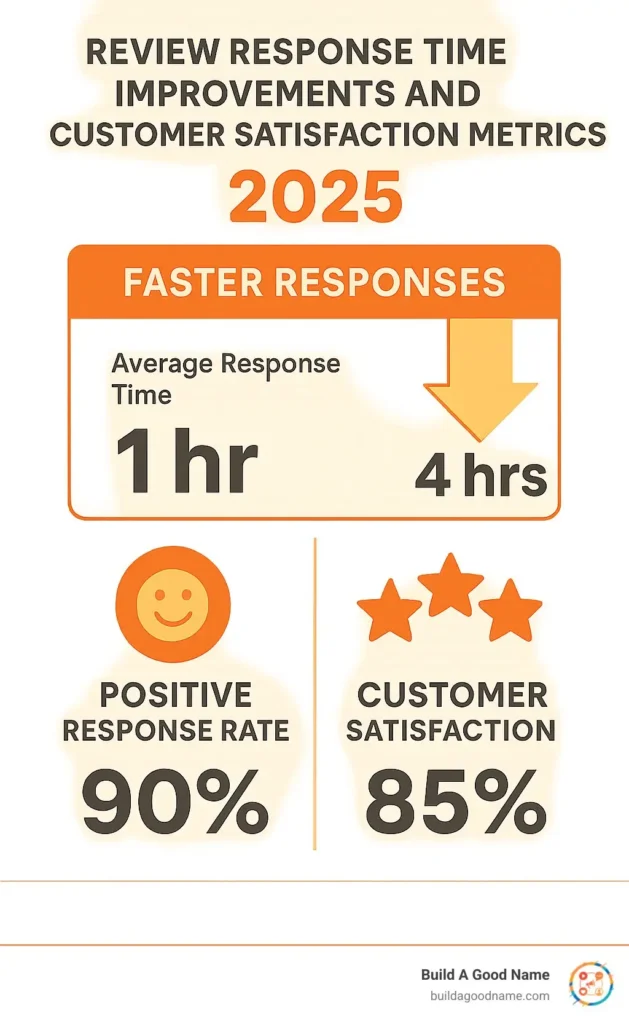
With fakes removed, you can answer real customers quickly and personally.
- Positive reviews: Acknowledge specifics—”Thanks for mentioning Sarah’s quick help!”
- Negative reviews: Offer solutions fast; companies using review tools cut response times by 8.5×.
Check out Best Responses to Google Reviews and Respond to Google Reviews for ready-to-use templates.
Filtered feedback fuels a continuous-improvement loop: listen, act, request fresh reviews, and watch trust compound.
A Practical Guide to Reporting and Removing Fake Reviews
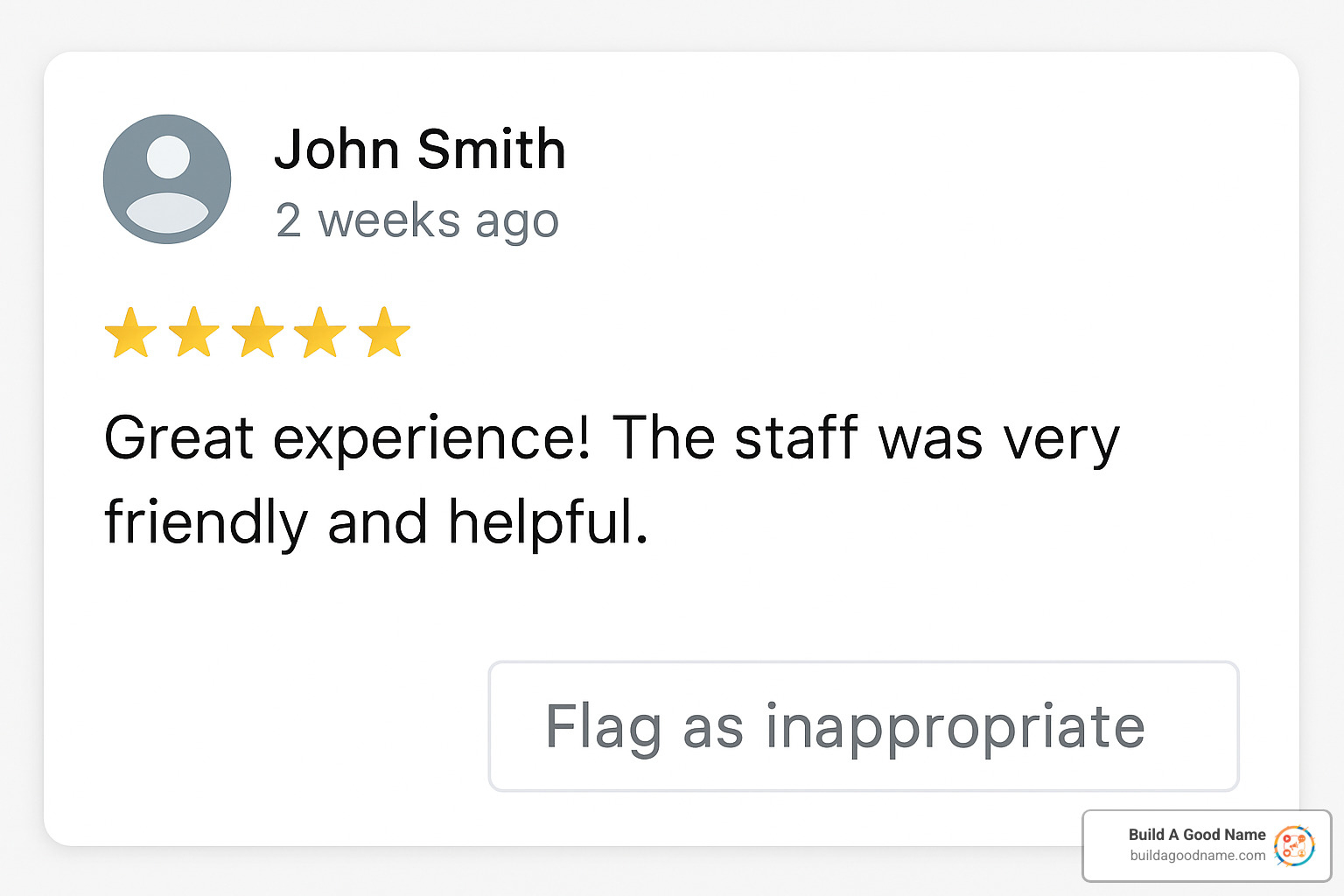
Sometimes your review filtering tool identifies fake reviews that need manual removal. While automated filtering catches most suspicious activity, there are times when you need to take direct action with review platforms to protect your business reputation.
The key to successful fake review removal lies in understanding that platforms want to maintain quality, but they receive thousands of reports daily. Your job is to make their decision as easy as possible by providing clear evidence and following their specific procedures.
Identifying policy violations requires knowing what each platform considers inappropriate. Most fake reviews violate multiple policies simultaneously – they might be deceptive, posted by non-customers, and contain suspicious language patterns. Understanding these overlapping violations strengthens your removal requests.
Documenting evidence properly makes the difference between successful and ignored reports. Take screenshots of the suspicious reviews, note unusual timing patterns, and gather information about reviewer profiles. If multiple fake reviews appeared within hours of each other, document that timing. If reviewers have suspicious posting histories, capture that evidence too.
The reporting process itself is usually straightforward, but success depends on providing specific details rather than vague complaints. Platforms need concrete reasons why a review violates their policies, not just assertions that it “seems fake.”
Following up on reports requires patience and persistence. Initial reports aren’t always successful, especially for borderline cases. Legitimate businesses often need to resubmit reports with additional evidence or clearer explanations of policy violations.
Understanding Platform Policies
Google’s spam detection systems work continuously in the background, but they’re not foolproof. The platform prohibits reviews that are deceptive, manipulated, or posted by individuals who haven’t actually experienced the business. However, enforcement can be inconsistent, especially for sophisticated fake review schemes.
Prohibited and restricted content includes obvious fakes, but also covers conflicts of interest, off-topic rants, and personal attacks. Reviews that focus on individual employees rather than the business, contain inappropriate language, or discuss experiences that clearly didn’t happen at your business all violate platform policies.
Consequences of violations create strong incentives for platforms to maintain quality. Businesses caught posting fake reviews face severe penalties including profile suspension and complete review removal. For legitimate businesses victimized by fake reviews, the consequences are subtler but equally damaging to reputation and revenue.
Platform policies evolve as companies adapt to new manipulation tactics. What worked to remove fake reviews last year might not work today, as platforms update their detection systems and policy enforcement. Staying informed about these changes through official platform communications helps you report violations more effectively.
For detailed guidance on Google’s specific policies, review their official guidelines which outline exactly what content is prohibited.
Step-by-Step: How to Flag a Fake Review
The mechanics of reporting fake reviews are similar across platforms, but success depends on providing specific, detailed information rather than generic complaints.
Locating the review you want to report should be straightforward, but make sure you’re reporting from the correct platform. A fake review on Google requires Google’s reporting process, while Facebook reviews need Facebook’s system.
Clicking the flag/report option usually involves finding a three-dot menu or flag icon near the review. These options are sometimes hidden or require multiple clicks to access, so take time to locate the correct reporting mechanism.
Selecting the violation type from the platform’s dropdown menu requires matching your evidence to their categories. Choose the most specific option available – “fake review” is better than “inappropriate content” if that option exists.
Submitting the report should include all your documented evidence and a clear explanation of why the review violates policies. Be specific about timing, language patterns, or reviewer behavior that seems suspicious. The more concrete details you provide, the easier you make the platform’s decision.
What to expect after reporting varies significantly by platform and violation type. Some obviously fake reviews disappear within days, while borderline cases might take weeks or months. Many platforms don’t provide status updates, so patience is essential.
The official process for Google is detailed in their guide on how to remove false Google reviews, which provides step-by-step instructions and realistic expectations for timing.
Persistence often pays off. If your first report isn’t successful, gather additional evidence and try again. Platforms are more likely to take action when they receive detailed, well-documented reports that make policy violations clear and undeniable.
Conclusion: Build a Better Business with Authentic Feedback
Think of review filtering tools as your business’s truth detector. They’re not about hiding criticism or painting an unrealistic picture – they’re about making sure every piece of feedback comes from real customers who actually experienced your business.
This distinction matters more than you might think. When fake reviews muddy the waters, you lose valuable insights that could improve your service. Your genuine customers’ voices get drowned out by manufactured opinions. And potential customers struggle to trust any feedback they see.
Filtering for authenticity, not censorship means embracing both positive and negative reviews – as long as they’re real. A thoughtful negative review from an actual customer is worth far more than a dozen fake five-star reviews. It tells you exactly what needs fixing and shows future customers that you’re human, responsive, and committed to improvement.
The businesses thriving in today’s review-heavy world understand this balance. They use sophisticated filtering technology to cut through the noise while actively encouraging authentic feedback from real customers. This approach creates a virtuous cycle: genuine reviews lead to better insights, which drive real improvements, which generate more positive authentic reviews.
Empowering businesses with true customer insights is what separates effective review management from simple damage control. When you can trust your feedback, you can make confident decisions about everything from staff training to product development. You stop second-guessing whether complaints are legitimate and start focusing on solutions.
At Build A Good Name, we’ve seen how transformative this clarity can be. Our AI-powered solutions don’t just filter out fake reviews – they help businesses build comprehensive strategies for authentic engagement. We understand that managing your online reputation requires more than basic monitoring. It requires smart filtering, thoughtful responses, and continuous improvement.
The future of reputation management is already here, and it’s built on authenticity. As review manipulation becomes more sophisticated, filtering technology evolves to match. The businesses investing in robust filtering tools now are positioning themselves for long-term success in an increasingly competitive digital landscape.
But here’s the thing – filtering alone isn’t enough. The most successful businesses combine effective filtering with proactive review generation, personalized response management, and genuine commitment to improvement. They understand that reputation management is about building trust, not just managing perception.
Ready to focus on what really matters? Your authentic customer feedback deserves better than getting lost in a sea of fake reviews. Our comprehensive approach to Filter Negative Reviews shows you how the right tools can transform your entire reputation management strategy.
The choice facing your business is simple: let fake reviews continue drowning out authentic customer voices, or take control with filtering tools that help you build something better. The technology exists, the benefits are proven, and the cost of waiting keeps growing.
Your real customers are trying to tell you something important. Isn’t it time you gave them the platform they deserve?

